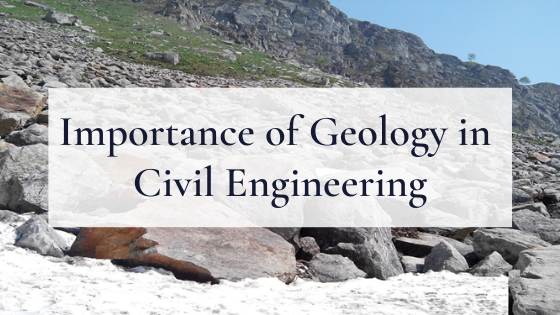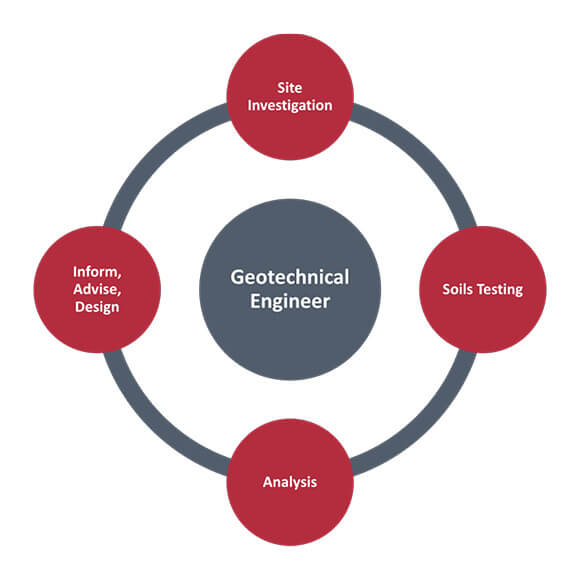Get This Report on Geotechnical Engineering For Construction Projects
Some Known Incorrect Statements About Geotechnical Engineering For Construction Projects
Table of ContentsGeotechnical Engineering For Construction Projects Can Be Fun For AnyoneThe Geotechnical Engineering For Construction Projects StatementsWhat Does Geotechnical Engineering For Construction Projects Do?Geotechnical Engineering For Construction Projects - QuestionsA Biased View of Geotechnical Engineering For Construction ProjectsGeotechnical Engineering For Construction Projects Fundamentals Explained
These functions should be taken a look at by geotechnical designers to anticipate their motions under different situations., making this evaluation necessary.A geotechnical engineer will certainly check out soil to identify the bearing capability of the planet and advise correct foundation types, such as shallow foundations, deep structures like stacks, or specialized options like floating structures for soft soils. Understanding the functions and activities of dirt and rock, along with exactly how they interact with constructions that have actually been set up on or within them, is among the key explanations for why geotechnical engineering is essential.
Along with architectural preparation and construction, geotechnical design is also essential to the repair and upkeep of pre-existing structures. Age-related destruction or added issues can affect a framework's security and efficiency. Ecological defense is achieved through geotechnical design. Know-how in air, water, and soil top quality maintenance is used by geotechnical designers to lessen the negative results of projects.
To sum up, geotechnical design is a crucial technique that maintains the durability and integrity of civil facilities. Geotechnical designers contribute to making building tasks reliable all over the globe by recognizing the behavior of earth products and using proper planning strategies.
Things about Geotechnical Engineering For Construction Projects
The fundamental stability of any type of project is crucial. Geotechnical engineering plays a vital role in ensuring that frameworks are built on strong ground, literally and figuratively. By taking a look at soil, rock, and subsurface conditions, geotechnical designers offer essential insights that aid in the design, building, and upkeep of buildings and facilities.

Getting My Geotechnical Engineering For Construction Projects To Work
Lab testing: Establishing the buildings of soil and rock. Area testing: Carrying out tests on-site to evaluate problems. Evaluation and layout: Using data to design foundations, keeping walls, tunnels, and other structures. Numerous top-level building and construction tasks have actually efficiently made use of geotechnical design to guarantee their stability and security. As an example:: The world's tallest structure needed a deep understanding of the underlying geology.
As a leader in geotechnical design, BECC Inc. is committed to supplying cutting-edge and effective remedies that satisfy the highest requirements of quality and safety and security., a mechanical designer and rock hound.
Little Known Facts About Geotechnical Engineering For Construction Projects.
Terzaghi additionally developed the framework for theories of bearing capacity of foundations, and the theory for prediction of the rate of negotiation of clay layers because of consolidation. After that, Maurice Biot completely established the three-dimensional soil combination theory, extending the one-dimensional design previously established by Terzaghi to extra general hypotheses and introducing the set of basic equations of Poroelasticity.
Geotechnical engineers examine and figure out the properties of subsurface conditions and products. They likewise design corresponding earthworks and retaining frameworks, passages, and framework structures, and may oversee and review sites, which may even more include site view surveillance as well as the threat analysis and mitigation of all-natural dangers - Geotechnical Engineering for Construction Projects. Geotechnical designers and design geologists execute geotechnical investigations to get details on the physical residential or commercial properties find this of soil and rock underlying and surrounding to a website to create earthworks and foundations for recommended frameworks and for the repair of distress to earthworks and frameworks triggered by subsurface problems.
The Greatest Guide To Geotechnical Engineering For Construction Projects
Geologic mapping and interpretation of geomorphology are generally completed in consultation with a geologist or engineering geologist. Subsurface expedition normally involves in-situ testing (for instance, the conventional infiltration examination and cone infiltration examination). The excavating of examination pits and trenching (specifically for locating mistakes and slide airplanes) might additionally be made use of to learn more about soil conditions at depth. Still, they are in some cases made use of to enable a rock hound or engineer to be decreased into the borehole for direct aesthetic and manual exam of the dirt and rock stratigraphy. Different dirt samplers exist to meet the demands of various design tasks. The basic infiltration test, which makes use of a thick-walled split spoon sampler, is the most common way to accumulate disrupted samples.

If the user interface in between the mass and the base of an incline has a complex geometry, incline stability analysis is difficult go to this web-site and mathematical solution techniques are needed. Generally, the user interface's exact geometry is unidentified, and a simplified interface geometry is thought. Limited slopes call for three-dimensional models to be evaluated, so most inclines are evaluated thinking that they are infinitely large and can be stood for by two-dimensional versions.
Everything about Geotechnical Engineering For Construction Projects
Creating the style based on a functioning hypothesis of habits prepared for under the most probable conditions. Selection of quantities to be observed as building proceeds and calculating their anticipated worths based on the functioning theory under the most negative problems.
Dimension of amounts and evaluation of real problems. It is inappropriate for projects whose style can not be changed during construction.